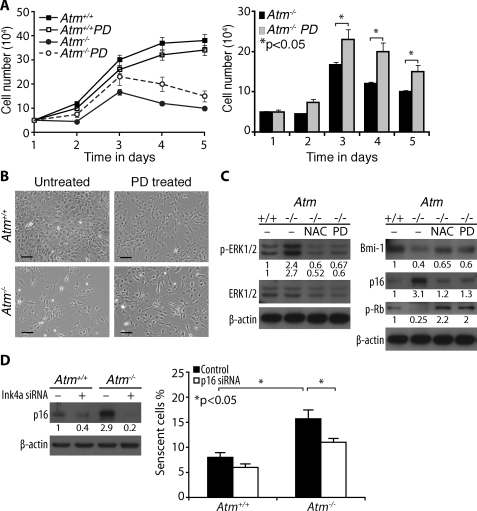FIGURE 6.
Restoration of normal proliferation of Atm-/- astrocytes by inactivation of ERK1/2 signaling or knockdown of p16Ink4a. A, growth curves of Atm+/+ and Atm-/- astrocytes, cultured either in the presence or absence of 50 μm PD98059. PD98059 partially rescued Atm-/- astrocytes from defective proliferation. The means ± S.D. of three independent countings are shown. *, p < 0.05 when PD98059-treated Atm-/- astrocytes were compared with untreated Atm-/- astrocytes. B, photomicrographs of Atm+/+ and Atm-/- astrocytes culture in the presence or absence of PD98059. Scale bars, 50 μm. C, Atm+/+ astrocytes were left untreated. Atm-/- astrocytes were either untreated left or treated with 1 mm NAC or 50 μm PD98059 for 2 days. The levels of phospho-ERK1/2, ERK1/2, Bmi-1, p16Ink4a, and phospho-Rb were determined by direct Western blotting analysis. D, Atm+/+ and Atm-/-astrocytes were transfected with Ink4a siRNA. p16Ink4a levels were determined by direct Western blotting analysis (left panel). Proportions of senescent cells were determined by SA β-galactosidase expression 2 days after cultivation (right panel). The means ± S.D. of three independent experiments are shown. *, p < 0.05 when untransfected Atm-/-astrocytes were compared with untransfected Atm+/+ culture or when Ink4a siRNA-transfected Atm-/-astrocytes were compared with untransfected Atm-/- astrocytes.

